Themed collection International Year of the Periodic Table : From Pb and Sn Perovskites to the Next Generation

When defects become ‘dynamic’: halide perovskites: a new window on materials?
If defects in materials cost more (energy) than decomposing them, defect densities will be low and thermodynamically controlled, with the right kinetics, as for halide perovskites.
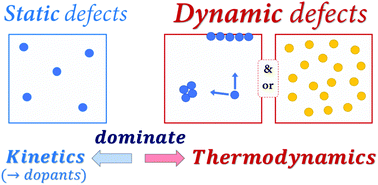
Mater. Horiz., 2019,6, 1297-1305
https://doi.org/10.1039/C9MH00606K
Advances in lead-free double perovskite nanocrystals, engineering band-gaps and enhancing stability through composition tunability
In this topical review, we have focused on the recent advances made in the studies of lead-free perovskites in the bulk form and as nanocrystals. We highlight how nanocrystals can serve as model systems to explore the schemes of cationic exchange, doping and alloying for engineering the electronic structure of double perovskites.

Nanoscale, 2019,11, 8665-8679
https://doi.org/10.1039/C9NR01031A
Will organic–inorganic hybrid halide lead perovskites be eliminated from optoelectronic applications?
In the development of perovskite solar cells, a new version of Don Quixote is needed if scientists are to keep on seeking the most celebrated works of literature, according to the evaluation criterion of ‘THE FIRST’ and ‘THE BEST’.
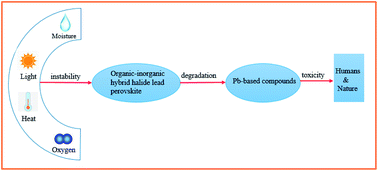
Nanoscale Adv., 2019,1, 1276-1289
https://doi.org/10.1039/C8NA00416A
Recent progress on highly sensitive perovskite photodetectors
The recent progress and developments on perovskite photodetectors are summarized from the perspective of device physics and materials science.
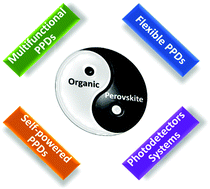
J. Mater. Chem. C, 2019,7, 1741-1791
https://doi.org/10.1039/C8TC06089D
Luminescent perovskite quantum dots: synthesis, microstructures, optical properties and applications
The synthesis, microstructures, optical properties and promising applications of luminescent perovskite quantum dots in optoelectronic fields are systematically reviewed.
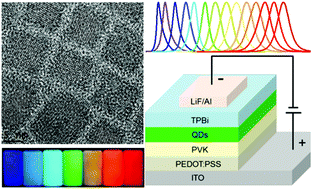
J. Mater. Chem. C, 2019,7, 1413-1446
https://doi.org/10.1039/C8TC05545A
Mesocrystals for photocatalysis: a comprehensive review on synthesis engineering and functional modifications
In this review, we mainly summarize the important progresses made in the development of photocatalysis-oriented mesocrystals, including synthesis engineering, functional modifications (hybridization and doping), and typical structure-related photocatalytic mechanisms. Some urgent issues and perspectives have also been discussed.
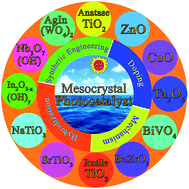
Nanoscale Adv., 2019,1, 34-63
https://doi.org/10.1039/C8NA00196K
Recent advances in one-dimensional halide perovskites for optoelectronic applications
This article reviews the achievements in synthesis techniques and nanoscale optoelectronic applications based on one-dimensional metal–halide perovskite nanocrystals.
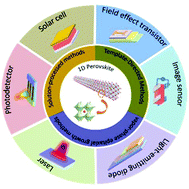
Nanoscale, 2018,10, 20963-20989
https://doi.org/10.1039/C8NR05862H
A review on morphology engineering for highly efficient and stable hybrid perovskite solar cells
Morphology engineering has been recognized as an effective way to attain highly efficient and stable hybrid perovskite solar cells.
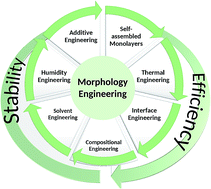
J. Mater. Chem. A, 2018,6, 12842-12875
https://doi.org/10.1039/C8TA04120B
Co-axial electrospray: a versatile tool to fabricate hybrid electron transporting materials for high efficiency and stable perovskite photovoltaics
A hybrid ETM is prepared using co-axial electrospray for the first time and used as an electron transporting material for perovskite solar cells with a high efficiency of 20.27%.
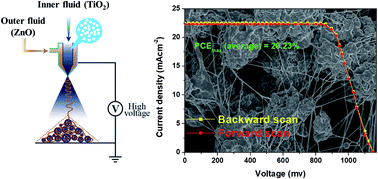
Nanoscale Adv., 2019,1, 1297-1304
https://doi.org/10.1039/C8NA00409A
Efficient methylammonium lead trihalide perovskite solar cells with chloroformamidinium chloride (Cl-FACl) as an additive
Highly efficient and stable mixed halide perovskite (MAPbI3–xClx) solar cells are fabricated with the incorporation of chloroformamidinium chloride (Cl-FACl).

J. Mater. Chem. A, 2019,7, 8078-8084
https://doi.org/10.1039/C9TA01319A
The top-down synthesis of single-layered Cs4CuSb2Cl12 halide perovskite nanocrystals for photoelectrochemical application
Herein, lead-free single-layered Cs4CuSb2Cl12 and Cs3M2X9 (X = Cl, Br, I; M = Sb, Bi) perovskite NCs have been prepared for the first time via a top-down liquid-phase ultrasonic exfoliation technique.
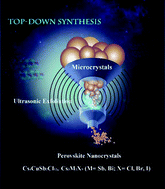
Nanoscale, 2019,11, 5180-5187
https://doi.org/10.1039/C9NR00375D
Synthesis of stable and phase-adjustable CsPbBr3@Cs4PbBr6 nanocrystals via novel anion–cation reactions
In this study, a novel anion–cation method to synthesize highly emissive and stable diphase CsPbBr3@Cs4PbBr6 composite NCs has been developed.

Nanoscale Adv., 2019,1, 980-988
https://doi.org/10.1039/C8NA00291F
Highly luminescent CsPbBr3 nanorods synthesized by a ligand-regulated reaction at the water–oil interface
We have synthesized highly luminescent CsPbBr3 nanorods through an oriented-attachment mechanism assisted by the ligand-regulation at the water–oil interface.
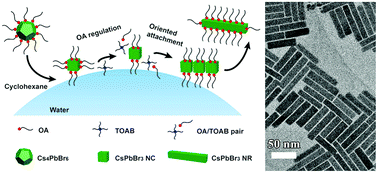
J. Mater. Chem. C, 2019,7, 1854-1858
https://doi.org/10.1039/C8TC06317F
Critical role of metal ions in surface engineering toward brightly luminescent and stable cesium lead bromide perovskite quantum dots
A facile metal ions-assistant ligand surface engineering strategy to synchronously boost photoluminescence quantum yield and stability of CsPbBr3 PQDs.
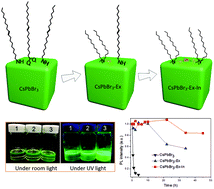
Nanoscale, 2019,11, 2602-2607
https://doi.org/10.1039/C8NR09350D
Polystyrene enhanced crystallization of perovskites towards high performance solar cells
Perovskite solar cells have attracted significant attention due to their high efficiency and low cost.
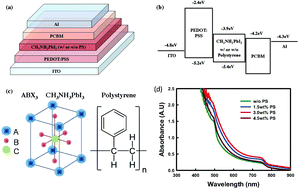
Nanoscale Adv., 2019,1, 76-85
https://doi.org/10.1039/C8NA00052B
MAPbI3 microneedle-arrays for perovskite photovoltaic application
Highly crystalline perovskite micro-needles are grown by a hydrothermal method and used in perovskite solar cells to yield 17.98% efficiency with no hysteresis.
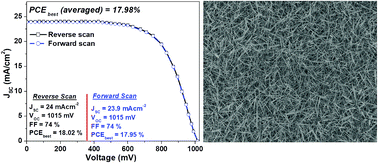
Nanoscale Adv., 2019,1, 64-70
https://doi.org/10.1039/C8NA00064F
Unexpected surface interactions between fluorocarbons and hybrid organic inorganic perovskites evidenced by PM-IRRAS and their application towards tuning the surface potential
Sticky perovskites! PM-IRRAS evidences that even simple fluorocarbons stick flat to methylammonium lead iodide hybrid perovskites and modify their properties.
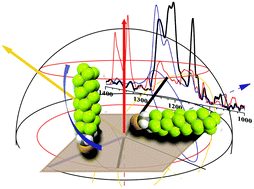
Mater. Horiz., 2019,6, 192-197
https://doi.org/10.1039/C8MH01119B
Enhanced moisture stability of metal halide perovskite solar cells based on sulfur–oleylamine surface modification
In this paper, oleylammonium polysulfides molecules were self-assembled on an etched perovskite film, leading to an enhancement in moisture stability of the devices.
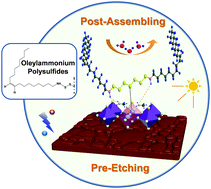
Nanoscale Horiz., 2019,4, 208-213
https://doi.org/10.1039/C8NH00163D
Preparation of perovskite-embedded monodisperse copolymer particles and their application for high purity down-conversion LEDs
Fabrication of angle-independent 3D photonic crystals with organic–inorganic hybrid perovskite nanoparticle-embedded copolymer particles for the extraction of a narrow emissive spectrum without angle-dependency.
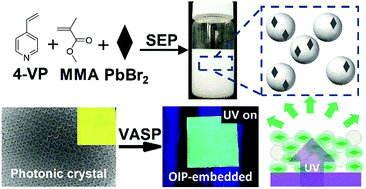
Mater. Horiz., 2018,5, 1120-1129
https://doi.org/10.1039/C8MH00619A
Mechanism suppressing charge recombination at iodine defects in CH3NH3PbI3 by polaron formation
Polaron formation prevents the hole trapping at the negatively charged iodine interstitial in CH3NH3PbI3.
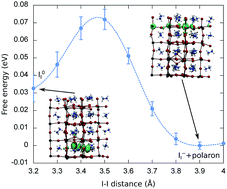
J. Mater. Chem. A, 2018,6, 16863-16867
https://doi.org/10.1039/C8TA06466K
A class of Pb-free double perovskite halide semiconductors with intrinsic ferromagnetism, large spin splitting and high Curie temperature
We introduce perovskite halides into spintronics, and these materials are ferromagnetic semiconductors with large spin splitting and high Curie temperatures.
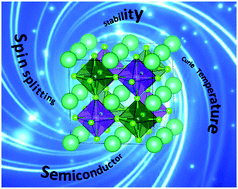
Mater. Horiz., 2018,5, 961-968
https://doi.org/10.1039/C8MH00590G
Integration of a functionalized graphene nano-network into a planar perovskite absorber for high-efficiency large-area solar cells
The concept of introducing a charge-collection nano-network into a perovskite layer points to a new direction towards up-scaling of high-efficiency PSCs.
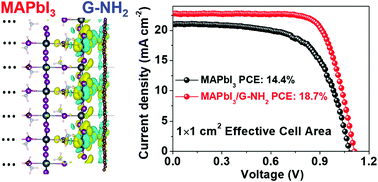
Mater. Horiz., 2018,5, 868-873
https://doi.org/10.1039/C8MH00511G
In situ synthesis and macroscale alignment of CsPbBr3 perovskite nanorods in a polymer matrix
Stretch-alignment of CsPbBr3 perovskite nanorods synthesized in situ in a polymer matrix leads to polarized emission.
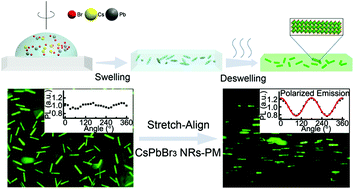
Nanoscale, 2018,10, 15436-15441
https://doi.org/10.1039/C8NR04895A
Understanding charge transfer and recombination by interface engineering for improving the efficiency of PbS quantum dot solar cells
In Mg-doped ZnO/PbS QDHSCs, a spike structure is formed between the QDs and the “electron acceptor”, which improved charge collection efficiency.
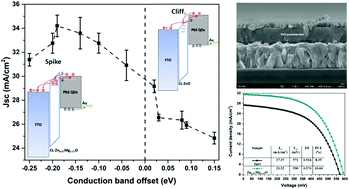
Nanoscale Horiz., 2018,3, 417-429
https://doi.org/10.1039/C8NH00030A
Tin and germanium based two-dimensional Ruddlesden–Popper hybrid perovskites for potential lead-free photovoltaic and photoelectronic applications
Lead-free tin (Sn) and germanium (Ge) based two-dimensional (2D) hybrid perovskites with a thickness of a few unit-cells possess desirable properties for photovoltaic and/or photoelectronic applications.
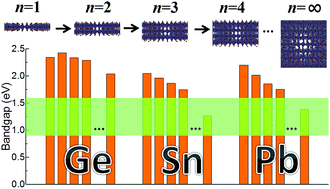
Nanoscale, 2018,10, 11314-11319
https://doi.org/10.1039/C8NR03589J
The effect of ionic composition on acoustic phonon speeds in hybrid perovskites from Brillouin spectroscopy and density functional theory
The impact of A and X site substitution on acoustic phonon speeds in hybrid perovskites with ABX3 stoichiometry is studied.
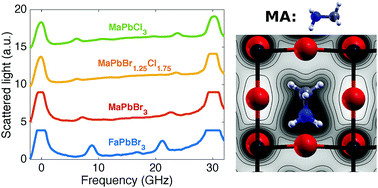
J. Mater. Chem. C, 2018,6, 3861-3868
https://doi.org/10.1039/C8TC00875B
A lead-free two-dimensional perovskite for a high-performance flexible photoconductor and a light-stimulated synaptic device
A high-performance flexible photoconductor based on a lead-free perovskite was made and it can be used as a light-stimulated synaptic device.
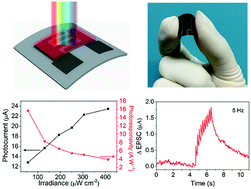
Nanoscale, 2018,10, 6837-6843
https://doi.org/10.1039/C8NR00914G
Inter-phase charge and energy transfer in Ruddlesden–Popper 2D perovskites: critical role of the spacing cations
Photo-generated charge carrier dynamics in Ruddlesden–Popper 2D perovskites with linear (n-BA) and branched (iso-BA) butylamine as spacing cations have been studied by using transient absorption and time-resolved photoluminescence spectroscopies.
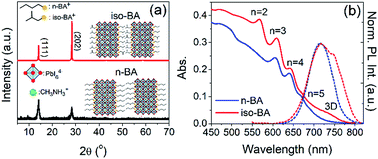
J. Mater. Chem. A, 2018,6, 6244-6250
https://doi.org/10.1039/C8TA01518J
A new formation strategy of hybrid perovskites via room temperature reactive polyiodide melts
The new precursors MAI3+x and FAI3+x exhibit exceptionally high reactivity towards lead precursors and result in high quality lead-halide perovskite films.
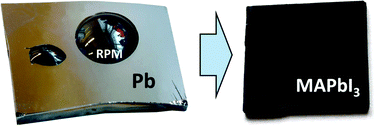
Mater. Horiz., 2017,4, 625-632
https://doi.org/10.1039/C7MH00201G
Perovskite quantum dots encapsulated in electrospun fiber membranes as multifunctional supersensitive sensors for biomolecules, metal ions and pH
Electrospun PMMA fiber membrane encapsulated with CsPbBr3 exhibits excellent FRET detection performance on trypsin, Cu2+ and pH.
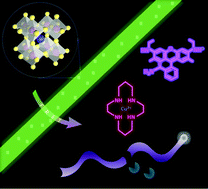
Nanoscale Horiz., 2017,2, 225-232
https://doi.org/10.1039/C7NH00057J
Molecular engineering of face-on oriented dopant-free hole transporting material for perovskite solar cells with 19% PCE
Dopant-free HTM KR321 showed highly ordered characteristic face-on organization leading to increased vertical charge transport and PCE over 19% in PSC with improved stability.
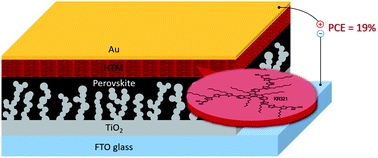
J. Mater. Chem. A, 2017,5, 7811-7815
https://doi.org/10.1039/C7TA01718A
Tetradic phosphor white light with variable CCT and superlative CRI through organolead halide perovskite nanocrystals
Exceptional CRI and variable CCT via fourfold phosphors to create a high-quality broadband white-emission with a controllable hue.

Nanoscale Adv., 2019,1, 1791-1798
https://doi.org/10.1039/C9NA00125E
Interfacial engineering for highly efficient quasi-two dimensional organic–inorganic hybrid perovskite light-emitting diodes
Metal halide-based perovskites are regarded as promising candidates for light-emitting diodes (LEDs) owing to their high color purity, tunable bandgap and solution processability.
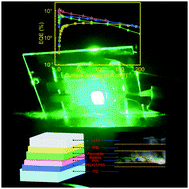
J. Mater. Chem. C, 2019,7, 4344-4349
https://doi.org/10.1039/C8TC06490C
Enhanced efficacy of defect passivation and charge extraction for efficient perovskite photovoltaics with a small open circuit voltage loss
A multifunctional 2D polymeric semiconductor was incorporated to provide surprisingly robust efficacy in grain boundary functionalization and defect passivation of perovskite, which suppresses charge recombination and thus affording an illustrious photovoltage of 1.16 V and power conversion efficiency of 21.1%.
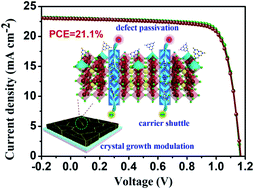
J. Mater. Chem. A, 2019,7, 9025-9033
https://doi.org/10.1039/C9TA01760G
New lead-free perovskite Rb7Bi3Cl16 nanocrystals with blue luminescence and excellent moisture-stability
The development of nontoxic and stable all-inorganic perovskite nanocrystals (NCs) represents a major challenge to unlock widely practical applications in photoelectric fields.
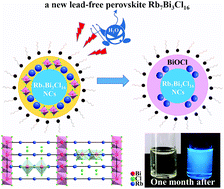
Nanoscale, 2019,11, 6719-6726
https://doi.org/10.1039/C9NR00600A
Low-dimensional formamidinium lead perovskite architectures via controllable solvent intercalation
We report the formation of a new class of solvent-intercalated two-dimensional (SI-2D) formamidinium lead halide perovskites.
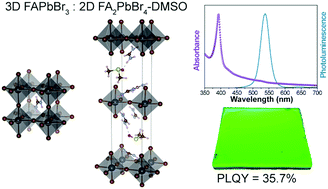
J. Mater. Chem. C, 2019,7, 3945-3951
https://doi.org/10.1039/C9TC00379G
Large area perovskite light-emitting diodes by gas-assisted crystallization
An anti-solvent free facile solution processing technique for fabricating perovskite light emitting diodes (PeLEDs), and scaling it up to large areas by slot-die coating.
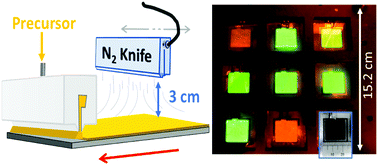
J. Mater. Chem. C, 2019,7, 3795-3801
https://doi.org/10.1039/C8TC06482B
Lead-free hybrid ferroelectric material based on formamidine: [NH2CHNH2]3Bi2I9
Novel room-temperature ferroelectric crystals with complex sequences of phase transitions.
![Graphical abstract: Lead-free hybrid ferroelectric material based on formamidine: [NH2CHNH2]3Bi2I9](/en/Image/Get?imageInfo.ImageType=GA&imageInfo.ImageIdentifier.ManuscriptID=C8TC06458J&imageInfo.ImageIdentifier.Year=2019)
J. Mater. Chem. C, 2019,7, 3003-3014
https://doi.org/10.1039/C8TC06458J
Effect of chloride substitution on interfacial charge transfer processes in MAPbI3 perovskite thin film solar cells: planar versus mesoporous
Electron injection from perovskite to planar TiO2 accelerates with chloride addition, in mesoporous TiO2 carrier recombination is slowed.
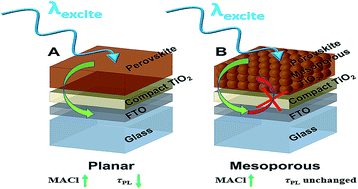
Nanoscale Adv., 2019,1, 827-833
https://doi.org/10.1039/C8NA00317C
Doping and phase segregation in Mn2+- and Co2+-doped lead halide perovskites from 133Cs and 1H NMR relaxation enhancement
Lead halide perovskites belong to a broad class of compounds with appealing optoelectronic and photovoltaic properties.
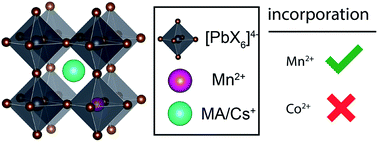
J. Mater. Chem. A, 2019,7, 2326-2333
https://doi.org/10.1039/C8TA11457A
Photo-oxidative degradation of methylammonium lead iodide perovskite: mechanism and protection
A new three-step photo-oxidative degradation mechanism of MAPbI3 is proposed. A strategy for protecting MAPbI3 by 2-(4-fluorophenyl)propan-2-amine modification is designed.
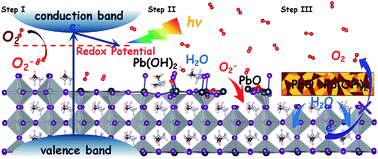
J. Mater. Chem. A, 2019,7, 2275-2282
https://doi.org/10.1039/C8TA12193A
Inorganic CsBi3I10 perovskite/silicon heterojunctions for sensitive, self-driven and air-stable NIR photodetectors
We report on the fabrication of a high-performance photodetector based on an inorganic CsBi3I10 perovskite/silicon heterojunction.
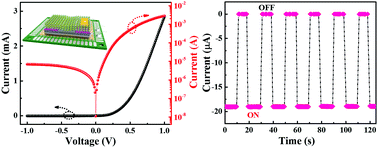
J. Mater. Chem. C, 2019,7, 863-870
https://doi.org/10.1039/C8TC05765F
Air-stable lead-free hybrid perovskite employing self-powered photodetection with an electron/hole-conductor-free device geometry
We have demonstrated the fabrication of one of the few lead-free perovskite self-powered photodetectors reported to date.

Nanoscale, 2019,11, 1217-1227
https://doi.org/10.1039/C8NR08959K
Influence of hole transport material ionization energy on the performance of perovskite solar cells
Here we show that the Voc in perovskite solar cells primarily depends on direct and trap-mediated recombination, rather than on the energetic offset between the valence band of the perovskite and the highest occupied molecular orbital of the organic transport layers.
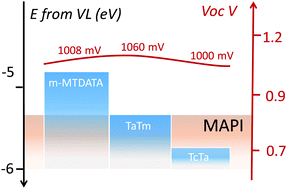
J. Mater. Chem. C, 2019,7, 523-527
https://doi.org/10.1039/C8TC05372C
Cell refinement of CsPbBr3 perovskite nanoparticles and thin films
In this work, we performed a detailed study of the phase transformations and structural unit cell parameters of CsPbBr3 nanoparticles (NPs) and thin films.
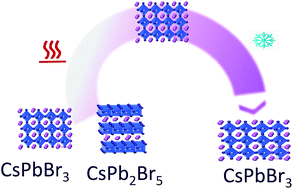
Nanoscale Adv., 2019,1, 147-153
https://doi.org/10.1039/C8NA00122G
Achieving highly saturated single-color and high color-rendering-index white light-emitting electrochemical cells by CsPbX3 perovskite color conversion layers
Saturated emission from light-emitting electrochemical cells integrated with CsPbX3 perovskite color conversion layers.
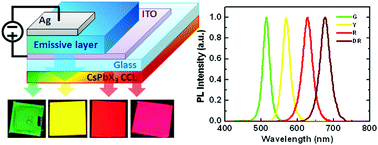
J. Mater. Chem. C, 2018,6, 12808-12813
https://doi.org/10.1039/C8TC04451A
First-principles characterization of two-dimensional (CH3(CH2)3NH3)2(CH3NH3)n−1GenI3n+1 perovskite
A novel two-dimensional Ge-based hybrid perovskite is proposed for potential optoelectronic applications.
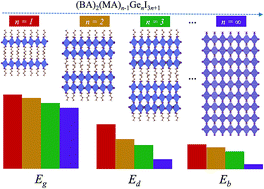
J. Mater. Chem. A, 2018,6, 24389-24396
https://doi.org/10.1039/C8TA10055A
Highly stable perovskite nanogels as inks for multicolor luminescent authentication applications
Full-spectral emissive perovskite nanogels present outstandingly improved photo-stability, thermal-stability and humidity-stability for anti-counterfeiting two-dimensional barcode application.

J. Mater. Chem. C, 2018,6, 11569-11574
https://doi.org/10.1039/C8TC04420A
Hybrid organic–inorganic lead bromide perovskite supercrystals self-assembled with L-cysteine and their good luminescence properties
The assembled supercrystals induced by crosslinking of L-cysteine exhibit strong fluorescence, high stability and a PL lifetime of 642 ns.
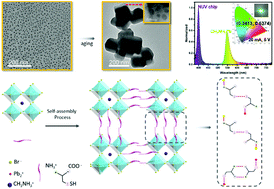
J. Mater. Chem. C, 2018,6, 10994-11001
https://doi.org/10.1039/C8TC03668C
Grain engineering by ultrasonic substrate vibration post-treatment of wet perovskite films for annealing-free, high performance, and stable perovskite solar cells
The ultrasonic substrate vibration post-treatment (SVPT) of wet perovskite films can eliminate the annealing process.
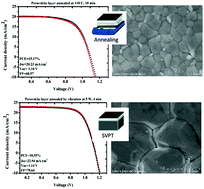
Nanoscale, 2018,10, 8526-8535
https://doi.org/10.1039/C8NR00540K
Lead-free, air-stable hybrid organic–inorganic perovskite resistive switching memory with ultrafast switching and multilevel data storage
The resistive switching memory based on a lead-free bismuth halide perovskite exhibits fast switching, multilevel data storage, and long-term air stability.
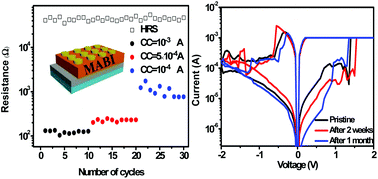
Nanoscale, 2018,10, 8578-8584
https://doi.org/10.1039/C8NR00863A
CaI2: a more effective passivator of perovskite films than PbI2 for high efficiency and long-term stability of perovskite solar cells
Much less additive content of 0.5% CaI2 instead of 5% PbI2 was incorporated into the CH3NH3PbI3 film and a dense and surface-smooth morphology was obtained with much enlarged crystal grains. The champion PSC based on MAPbI3(CaI2)0.005 layer demonstrated a very high PCE of 19.3% with superior long-term stability.

J. Mater. Chem. A, 2018,6, 7903-7912
https://doi.org/10.1039/C7TA11280G
Facile surface modification of CH3NH3PbI3 films leading to simultaneously improved efficiency and stability of inverted perovskite solar cells
Surface modification based on 4-DMABA allows for the enhancement of efficiency and stability of an inverted perovskite solar cell. This is ascribed to the passivation of the surface traps and recombination suppression, and to the hydrophobic surface capping layer, respectively.

J. Mater. Chem. A, 2018,6, 6255-6264
https://doi.org/10.1039/C8TA00267C
Enhanced performance of perovskite solar cells via anti-solvent nonfullerene Lewis base IT-4F induced trap-passivation
We have developed a new method to introduce defect passivation agents using an in situ technique for planar p–i–n perovskite solar cells, during the anti-solvent deposition step.
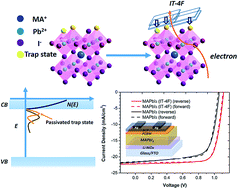
J. Mater. Chem. A, 2018,6, 5919-5925
https://doi.org/10.1039/C8TA00583D
Influence of water intercalation and hydration on chemical decomposition and ion transport in methylammonium lead halide perovskites
The application of methylammonium (MA) lead halide perovskites, CH3NH3PbX3 (X = I, Br, Cl), in perovskite solar cells has made great recent progress in performance efficiency during recent years.

J. Mater. Chem. A, 2018,6, 1067-1074
https://doi.org/10.1039/C7TA09112E
Insights into the increased degradation rate of CH3NH3PbI3 solar cells in combined water and O2 environments
Halide perovskites offer low cost and high efficiency solar cell materials but serious issues related to air and moisture stability remain.
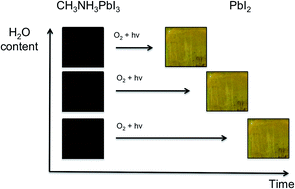
J. Mater. Chem. A, 2017,5, 25469-25475
https://doi.org/10.1039/C7TA06841G
Intrinsic and interfacial kinetics of perovskite solar cells under photo and bias-induced degradation and recovery
Perovskite solar cells (PSCs) have emerged as a potential candidate for high efficiency low-cost photovoltaic technology.
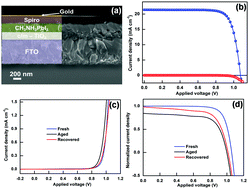
J. Mater. Chem. C, 2017,5, 7799-7805
https://doi.org/10.1039/C7TC02652H
Tuning CH3NH3Pb(I1−xBrx)3 perovskite oxygen stability in thin films and solar cells
Degradation analysis of CH3NH3Pb(I1−xBrx)3 mixed halide perovskites, showing promising environmental stability of CH3NH3PbBr3.
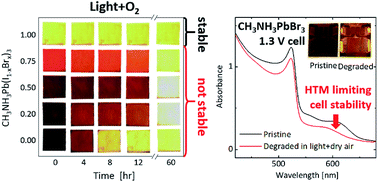
J. Mater. Chem. A, 2017,5, 9553-9560
https://doi.org/10.1039/C7TA00058H
Inducing swift nucleation morphology control for efficient planar perovskite solar cells by hot-air quenching
We introduce a pin-hole free CH3NH3PbI3−xClx perovskite layer by using heated airflow during the nucleation stage. We control the nucleation stage which gives a pin-hole free planar perovskite with large grains, resulting in a maximum power point (MPP) efficiency of 14.3% and a high efficiency of 19.0% with reproducibility.
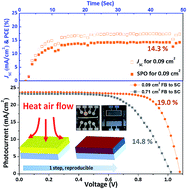
J. Mater. Chem. A, 2017,5, 3812-3818
https://doi.org/10.1039/C6TA09020F
The mechanism of toluene-assisted crystallization of organic–inorganic perovskites for highly efficient solar cells
We investigate the influence of solvent drenching in hybrid organic–inorganic perovskite (CH3NH3PbX) crystallization process with a non-solvent, toluene, during film fabrication process.
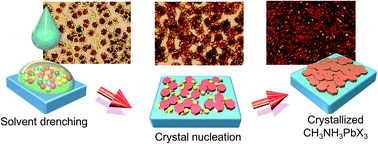
J. Mater. Chem. A, 2016,4, 4464-4471
https://doi.org/10.1039/C6TA01087C
About this collection
Guest Edited by;
Henry Snaith, Materials Horizons Editorial Board Member, University of Oxford, UK
Martyn McLachlan, Journal of Materials Chemistry C Associate Editor, Imperial College London, UK
Xiaogang Liu, Nanoscale Associate Editor, National University of Singapore, Singapore
Xiao Cheng Zeng, Nanoscale Associate Editor, University of Nebraska Lincoln, USA
Zhiqun Lin, Journal of Materials Chemistry A Associate Editor, Georgia Institute of Technology, USA
Monica Lira-Cantú, Journal of Materials Chemistry C Associate Editor, Catalan Institute of Nanoscience and Nanotechnology, Spain
Aron Walsh, Materials Horizons Scientific Editor, Imperial College London, UK
This themed collection is the third in a series celebrating the International Year of the Periodic Table. ‘From Pb and Sn Perovskites to the Next Generation’ features papers from across the Materials and Nano journal portfolio, including Materials Horizons, Nanoscale Horizons, Journal of Materials Chemistry A, B, C, Nanoscale, and Nanoscale Advances. The papers selected for this themed issue focus on the current hot trends in the perovskite field, particularly halide perovskites and their promise in solar cell applications as well as non-oxide all-inorganic perovskites.